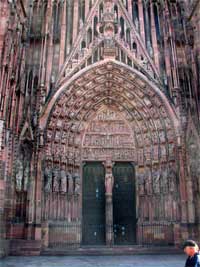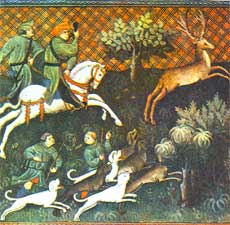Gothic Art
Gothic Art covered a period of four centuries, from the 12th to the beginning of the 16th century. Gothic art and architecture first appeared in France. It can be said that, since the days when the Greeks invented the Doric and Ionic, no society had ever developed a style of architecture more personally expressive. There was something marvelous in this phenomenon, and its cause is to be found in the new position of the communes (the cities of France). Their population conquered a prominent place in the society, side by side with the feudals and clergy.

Notre-Dame de Strasbourg
Central Portal-Western Façade
Gothic: the Urban Character of Art
Gothic art is urban par excellence. Quite the opposite, Romanesque art was developed mostly in the monastic environment. While the feudal class laid the foundation of the castle architecture, it was the population of the communes who built the Gothic cathedrals. Within the walls of the cities, the urban civilization began to flourish, guilds and corporations were formed, and the bourgeoisie and workmen started to assert their role in society.
True, the new art started in the religious environment, but evolved in a surprisingly dogma-free manner, so that it gave us the masterpieces of civil architecture like the Jacques Coeur Palace in Bourges, and the civic buildings in the Low Countries.
The crusades increased the power of kings, reinvigorated commerce, and raised the importance and prosperity of the cities. When France became what Germany had been, the leading state of Europe, her kings began to consolidate their territories.
The feudal lords opposed the process, so the Kings of France allied themselves with the communes, which were also the main source of money for the monarchy. The league between them and royalty in France was a joint partnership of opposition to the power of the nobles.
The public spirit of the cities evolved based on this alliance. It was more prominent in Gothic art because the relation between public and art was direct. The cathedrals were built by the population of the cities, guided by their strong religious belief, and they were seen and used by all the citizens who had helped to pay for their construction. The huge monuments were not only works of art, they expressed municipal pride, the entire town being devoted to the task of building them. In an endless competition between cities, the buildings had to be vast, so that they could shelter the population of an entire city, and the spires rose higher and higher. People took a personal pride in the cathedral and all felt a personal rivalry with every other city which was boasting its own great building.
We should not underestimate the influence the church and its revered clergy had on Gothic Art. During the Dark Ages, the convents were centers of instruction, and the clergy were the guardians of treasuries of civilization. In the Middle Ages, the clergy, besides teaching religion, were the masters of science, literature, diplomacy, and even of the art of war. They became the honored masters of their time, and the cathedrals are proof of the power of the church, built, however, by the efforts of people belonging to all classes, driven by religious faith and a huge charitable impulse.
Characteristics of the Gothic Period Art- The Art was essentially original. It appeared in Île-de-France without any external or historical influence.
- It was rational. It is the result of the most logical approach. In a Gothic building there is an absolute concordance between form and structure.
- Gothic art was realistic, replacing the abstract of the Romanesque with the tendency to observe, and cultivating the study of nature in sculptures and paintings. Its realism was determined by the role the cathedrals had in everyday life. They were in the same time civic buildings, used for town meetings, for public festivals, and for "miracle plays", being always open to the public.
Gothic Cathedral ArtArt during the Gothic period was reflecting the huge importance religion had in people's life. The lessons and the stories of the Bible had to be taught by paintings, sculptures, and stained glass, the cathedral being an immense visual library. It was also a museum of art, meant to teach by paintings and reliefs the history of the world as comprehended by the traditions of the church, and the lessons of faith and of sacrifice. The message of its art had to be clearly understood by rich and poor alike, who were all gathering under its roof on equal terms.

Hunting Scene
Livre de la Chasse de Gaston Phoebus
1380-Bibliothèque Nationale, Paris
The sculptures and the painted windows of the religious buildings influenced even miniature paintings. A new miniature painting style emerged in the 13th Century, employing more vivid colors in trying to emulate the splendor of stained glass. Many vignettes recalled the design of the Gothic windows and their mullions.
The architecture had the main role in establishing local Gothic styles, and, on a larger scale, marked the distinction between the North and the South. The main difference consisted in the wall surfaces available for painting, which in the case of Northern Gothic became more limited than in the basilicas in the South.
Emancipated from monastic limitations, Gothic art became more human, more open to nature and beauty. Born in the religious environment, but rapidly adopted by the secular world, Gothic art was not only a movement, but the defining attribute of an entire epoch.
